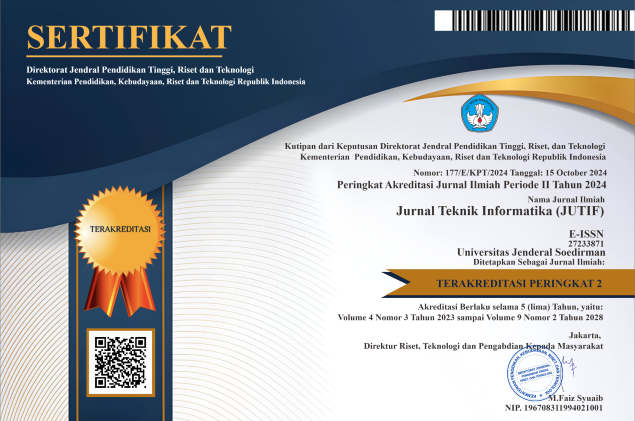Literature Study on AI Mechanisms, Consciousness, and Emotion Integration in Chat GPT
DOI:
https://doi.org/10.52436/1.jutif.2025.6.4.4985Keywords:
Artificial Consciousness, Artificial Intelligence, ChatGPT, Emotion Simulation, Human-AI Interaction, Predictive AlgorithmsAbstract
The development of artificial intelligence (AI), particularly ChatGPT, demonstrates the ability to generate responses that resemble human emotional understanding and raises questions about the integration of consciousness, emotions, and algorithms in the context of singularity. This study aims to analyze how AI builds the illusion of consciousness and emotional closeness through computational mechanisms and its impact on human-AI interactions across various sectors. The method used is a structured literature review, examining academic journals, official reports, and the latest technical documentation classified by technical domain, including model architecture, emotion simulation, ethical implications, and publication year to assess its developmental dynamics. The results show that ChatGPT is capable of simulating empathy through affective computing and language prediction patterns, but it does not possess subjective emotional experiences like humans. This illusion of emotional closeness has proven beneficial in enhancing the effectiveness of interactions in education, public services, and healthcare, although it also poses risks such as emotional manipulation, data bias, and unrealistic empathy standards. The discussion emphasizes that the term “empathy” in AI should be understood technically as a data-driven adaptive response, not authentic emotional experience, and thus must be distinguished from human empathy. Critical analysis also reveals contradictions between AI's effectiveness in mimicking human behavior and its limitations in achieving genuine emotional connection. The discussion emphasizes that the term “empathy” in AI should be understood technically as a data-driven adaptive response, not an authentic emotional experience, and therefore needs to be distinguished from human empathy. Critical analysis also reveals a contradiction between AI's effectiveness in mimicking emotional behavior and its limitations in understanding meaning and consciousness at a deeper level. Therefore, this research contributes to the field of Computer Science by presenting a conceptual synthesis that clarifies both the limitations and potential of AI, while offering a foundation for designing more ethical interaction systems and developing risk assessment models in vulnerable sectors.
Downloads
References
I. Cholissodin and A. A. Soebroto, “AI , MACHINE LEARNING & DEEP LEARNING ( Teori & Implementasi ),” Univ. Brawijaya, 2020, [Online]. Available: https://www.researchgate.net/profile/Imam_Cholissodin/publication/348003841_Buku_Ajar_AI_Machine_Learning_Deep_Learning/links/5fee9968299bf14088610ab0/Buku-Ajar-AI-Machine-Learning-Deep-Learning.pdf
P. Butlin et al., Consciousness in Artificial Intelligence: Insights from the Science of Consciousness. Cornell University, 2023. [Online]. Available: http://arxiv.org/abs/2308.08708
M. Kurniawan, “Tren Pencarian Bergeser, dari ”Googling” ke AI Generatif,” Kompas.id. Accessed: Jun. 19, 2025. [Online]. Available: https://www.kompas.id/artikel/tren-pencarian-bergeser-dari-googling-ke-ai-generatif
N. Simone, artificial intelligence and social life after the Turing Test. New York: the United States of America by Oxford University Press, 2021. doi: 10.1093/oso/9780190080365.001.0001.
N. News.co.id, “Nasib Umat Manusia dalam Era Singularitas Teknologi,” Nasional News.co.id. Accessed: Jun. 29, 2025. [Online]. Available: https://nasionalnews.co.id/nasib-umat-manusia-dalam-era-singularitas-teknologi/
G. S. Mahendra et al., Tren Teknologi AI (Pengantar, Teori dan Contoh Penerapan di Berbagai Bidang). Singaraja: SONPEDIA Publishing Indonesia, 2024. [Online]. Available: https://www.researchgate.net/publication/381514165_TREN_TEKNOLOGI_AI_Pengantar_Teori_dan_Contoh_Penerapan_Artificial_Intelligence_di_Berbagai_Bidang
Amazon, “Apa Itu Kecerdasan Buatan (AI)?,” Amazon. Accessed: Jun. 20, 2025. [Online]. Available: https://aws.amazon.com/id/what-is/artificial-intelligence/
E. S. Eriana and D. A. Zein, Artificial Intelligence, vol. 6(11). pamulang: cv.eureka media aksara, 2023. [Online]. Available: https://repository.penerbiteureka.com/media/publications/567027-artificial-intelligence-ai-a351ede6.pdf
C. Tarsney, “Deception and manipulation in generative AI,” Philos. Stud., 2024, doi: 10.1007/s11098-024-02259-8.
Tim DetikINET, “Peneliti Sebut Teknologi AI Ahli dalam Menipu Manusia, Ini Buktinya!,” DetikSulsel, Sep. 11, 2023. [Online]. Available: https://www.detik.com/sulsel/berita/d-6924630/peneliti-sebut-teknologi-ai-ahli-dalam-menipu-manusia-ini-buktinya
T. Suminar, “Kajian Film Ex-Machina: Proyeksi Eksistensi Artificial Intellegence terhadap Manusia Informasi di Masa Depan,” WordPress. Accessed: Jun. 19, 2025. [Online]. Available: https://oratoretina.wordpress.com/2016/05/14/kajian-film-ex-machina-proyeksi-eksistensi-artificial-intellegence-terhadap-manusia-informasi-di-masa-depan/
V. Chavan, A. Cenaj, and S. Shen, “Feeling Machines: Ethics, Culture, and the Rise of Emotional AI,” Cornell Univ., 2025, doi: 10.48550/arXiv.2506.12437.
B. Kotchoubey, “Human consciousness: Where is it from and what is it for,” Front. Psychol., 2018, doi: 10.3389/fpsyg.2018.00567.
I. Cholissodin and A. S. Andy, AI, MACHINE LEARNING & DEEP LEARNING (Teori & Implementasi), 1.01. Malang: Universitas Brawijaya FILKOM, 2020. [Online]. Available: https://www.researchgate.net/profile/Imam_Cholissodin/publication/348003841_Buku_Ajar_AI_Machine_Learning_Deep_Learning/links/5fee9968299bf14088610ab0/Buku-Ajar-AI-Machine-Learning-Deep-Learning.pdf
V. Bey, “Fenomena Artificial Intelligence dan Bahaya Dehumanisasi,” J. Akad., vol. 23, no. 1, pp. 1–10, 2023, [Online]. Available: https://journal.iftkledalero.ac.id/index.php/AKD/article/download/11/10/85
E. Helbert, “AI’s Growing Pervasiveness in Society,” THE AI JURNAL. Accessed: Aug. 15, 2025. [Online]. Available: https://aijourn.com/ais-growing-pervasiveness-in-society/
N. Dienwati, K. Anam, and R. Narasati, ChatGPT dan Transformasi Sosial. MINHAJ PUSTАКА, 2024. [Online]. Available: https://repository.minhajpustaka.id/media/publications/593911-chatgpt-dan-transformasi-sosial-perspekt-575b89c2.pdf
LITSLINK, “ChatGPT sebagai Model Bahasa Besar (LLM): Properti dan Keunikannya,” LITSLINK. Accessed: Aug. 14, 2025. [Online]. Available: https://litslink.com/blog/chatgpt-as-a-large-language-model-llm
DQLab, “Pengertian Chat GPT & Cara Menggunakannya,” DQLab. Accessed: Jun. 19, 2025. [Online]. Available: https://dqlab.id/pengertian-chat-gpt-and-cara-menggunakannya
Y. Ju and H. Ma, “Training Data for Large Language Model,” 2024, [Online]. Available: https://arxiv.org/abs/2411.07715
E. Hermann, “Anthropomorphized artifcial intelligence, attachment, and consumer behavior,” Springer, 2021, doi: https://doi.org/10.1007/s11002-021-09587-3.
T. Natsoulas, “Concepts of Consciousness,” JSTOR, vol. 42, 2017, [Online]. Available: https://www.jstor.org/stable/43852954
R. C. Atkinson and R. M. Shiffl’in, “The Control of Short-Term Memory,” pp. 82–90, 1971, [Online]. Available: https://www.jstor.org/stable/24922803
A. Budson, R. Kenneth, and E. A. Kensinger, “Consciousness as a Memory System,” 2022, doi: 10.1097/WNN.0000000000000319.
S. Chen, S. Ma, S. Yu, H. Zhang, S. Zhao, and C. Lu, “Exploring Consciousness in LLMs: A Systematic Survey of Theories, Implementations, and Frontier Risks,” 2025, [Online]. Available: http://arxiv.org/abs/2505.19806
CRYSTAL, “Bagaimana Cara Kerja Artificial Intelligence yang Sesungguhnya?” [Online]. Available: https://crystalsea.id/blog/cara-kerja-artificial-intelligence/?srsltid=AfmBOopvIY4BSe187b2rYQg1h0kIksCrIoE8TwgsG1dwffAp4xkRTbjf
M. K. Dr. Teguh, Joseph Santoso, S.Kom., Kecerdasan Buatan. Semarang: Yayasan Prima Agus Teknik, 2023. [Online]. Available: https://digilib.stiestekom.ac.id/ebook/view/kecerdasan-buatan-artificial-intelligence
Tedi Lesmana Marselino, “Kemungkinan Kesadaran Kecerdasan Artifisial Komputer : Suatu Telaah Terhadap Gagasan Metaan Kesadaran Mesin David Gamez,” Sekolah Tinggi Filsafat Driyarkara, 2022. [Online]. Available: http://repo.driyarkara.ac.id/919/2/Summary.pdf
A. Lindner, M. Berges, M. Rösch, and F. Franke, Education and awareness for artificial intelligence, vol. 14296 LNCS. 2023. doi: 10.1007/978-3-031-44900-0_3.
“Figure 2 - available via license: Creative Commons Attribution-NonCommercial-NoDerivatives 4.0 International,” ResearchGate. Accessed: Aug. 17, 2025. [Online]. Available: https://www.researchgate.net/figure/The-Turing-test-C-123RF_fig2_357618741
A. Hakim, “Batas Artificial Intelligence : Antara Komputasi dan Kesadaran Manusia,” 2025, [Online]. Available: https://www.academia.edu/129594827/Batas_Artificial_Intelligence_Antara_Komputasi_dan_Kesadaran_Manusia
S. K, “Artificial Intelligence and Human Consciousness,” SSRN Electron. J., 2022, doi: 10.2139/ssrn.4070609.
Z. Zhou, “Emotional thinking as the foundation of consciousness in artificial intelligence,” Cult. Sci., vol. 4, no. 3, pp. 112–123, 2021, doi: 10.1177/20966083211052651.
INSTITUT BISNIS DAN TEKNOLOGI INDONESIA, “5 Alasan Mengapa Manusia Tak Tergantikan dengan AI,” INSTIKI. Accessed: Aug. 18, 2025. [Online]. Available: https://instiki.ac.id/2023/02/25/5-alasan-mengapa-manusia-tak-tergantikan-dengan-ai/
I. Azkia Agustina, R. Purnamasari, and S. Maemunah, “Kajian Psikologi Sastra Teori David Krech Dalam Lagu ‘Semua Aku Dirayakan’ Karya Nadin Amizah,” PENTAS J. Ilm. Pendidik. Bhs. dan Sastra Indones., vol. 11, no. 1, pp. 34–43, 2025, [Online]. Available: https://e-jurnal.unisda.ac.id/index.php/pentas%7C%7C
M. QIBTIYAH, “EMOSI DALAM PERSPEKTIF AL QUR’AN,” UNIVERSITAS PTIQ JAKARTA, Jakarta, 2023. [Online]. Available: https://repository.ptiq.ac.id/id/eprint/1393/1/Emosi dalam perspektif al-Qur%27an - Maria Qibtiyah.pdf
M. Cabanac, “What is emotion?,” Behav. Processes, vol. 60, no. 2, pp. 69–83, 2002, doi: 10.1016/S0376-6357(02)00078-5.
J. E. Ledoux, “Emotion circuits in the brain,” Annu Rev Neurosci, vol. 23, pp. 155–184, 2000, doi: 10.1146/annurev.neuro.23.1.155.
L. Pessoa, “On the relationship between emotion and cognition,” vol. 9, 2008, doi: 10.1038/nrn2317.
A. Kapoor and V. Verma, “Emotion Ai : Understanding Emotions Through,” Int. J. Eng. Sci. Humanit., vol. 1, no. 1, pp. 224–232, 2024, doi: 10.62904/0vcbvb24.
A. O. R. Vistorte, A. Deroncele-Acosta, J. L. M. Ayala, A. Barrasa, C. López-Granero, and M. Martí-González, “Integrating artificial intelligence to assess emotions in learning environments: a systematic literature review,” Front. Psychol., vol. 15, no. June, 2024, doi: 10.3389/fpsyg.2024.1387089.
D. H. Vicci, “Emotional Intelligence in Artificial Intelligence: A Review and Evaluation Study,” SSRN Electron. J., no. May, 2024, doi: 10.2139/ssrn.4818285.
C. Bhardwaj, “36 Use Cases and Examples of AI Emotion Recognition,” appinventiv. Accessed: Aug. 17, 2025. [Online]. Available: https://appinventiv.com/blog/emotion-ai-applications-and-examples/
N. Diswantika and Y. Y. Riksa, “MODEL BIMBINGAN DAN KONSELING BERMAIN COGNITIVE-BEHAVIOR PLAY THERAPY UNTUK MENGEMBANGKAN EMPATI MAHASISWA,” J. Mhs. BK AN-NUR BERBEDA BERMAKNA MULIA, 2022, doi: 10.31602/jmbkan.v8i1.6215.
I. Lanin, “Empati AI,” medium.com. Accessed: Aug. 17, 2025. [Online]. Available: https://ivanlanin.medium.com/empati-ai-3f01ff8f9a5b
M. R. Edy, “Deteksi Emosi dari Ekspresi Wajah dengan Deep Learning,” Inf. Technol. Educ. J., vol. 3, no. 2, pp. 116–123, 2024, [Online]. Available: https://journal.unm.ac.id/index.php/INTEC/article/view/2866
W. Jiaqi, W. Bo, and G. Fa, “A comparative study of large language models and human personality Personality Traits,” Cornell Uni, 2025, doi: https://doi.org/10.48550/arXiv.2505.14845.
B. Yu and J. Kim, “PERSONALITY OF AI,” 2023, doi: https://doi.org/10.48550/arXiv.2312.02998.
J. Joseph, “The algorithmic self: how AI is reshaping human identity, introspection, and agency,” Front. Psychol., vol. 16, 2025, doi: 10.3389/fpsyg.2025.1645795.
R. Goel, S. Susan, S. Vashisht, and A. Dhanda, “Emotion-Aware Transformer Encoder for Empathetic Dialogue Generation,” Int. Conf. Affect. Comput. Intell. Interact. Work. Demos, 2021, doi: 10.1109/ACIIW52867.2021.9666315.
C. Creangă and L. P. Dinu, “ISDS-NLP at SemEval-2024 Task 10: Transformer based neural networks for emotion recognition in conversations,” SemEval 2024 - 18th Int. Work. Semant. Eval. Proc. Work., vol. 3, no. Table 1, pp. 649–654, 2024, doi: https://doi.org/10.48550/arXiv.2405.11222.
H. Gunes and N. Churamani, “Affective Computing for Human-Robot Interaction Research: Four Critical Lessons for the Hitchhiker,” IEEE Int. Work. Robot Hum. Commun. RO-MAN, pp. 1565–1572, 2023, doi: https://doi.org/10.48550/arXiv.2303.18176.
M. Roshanaei, R. Rezapour, and M. S. El-Nasr, “Talk, Listen, Connect: Navigating Empathy in Human-AI Interactions,” vol. 1, no. 1, 2024, [Online]. Available: http://arxiv.org/abs/2409.15550
M. Mohammad and X. Che, “CONSCIOUSNESS IN AI SYSTEMS: A REVIEW,” 2025, doi: 10.5121/ijaia.2025.16205.
A. Cuadra et al., “The Illusion of Empathy? Notes on Displays of Emotion in Human-Computer Interaction,” Conf. Hum. Factors Comput. Syst. - Proc., 2024, doi: 10.1145/3613904.3642336.
W. Knight, “This New Tech Puts AI In Touch With Its Emotions—and Yours,” WIRED.com. Accessed: Aug. 17, 2025. [Online]. Available: https://www.wired.com/story/hume-ai-emotional-intelligence/?utm
Y. Kumar, “The Ethics of Artificial Emotions: Should Machines Feel?,” SHARPENER.com. Accessed: Aug. 17, 2025. [Online]. Available: https://gosharpener.com/blogs/670245/The-Ethics-of-Artificial-Emotions-Should-Machines-Feel?utm
A. Pant, R. Hoda, S. V. Spiegler, C. Tantithamthavorn, and B. Turhan, “Ethics in the Age of AI: An Analysis of AI Practitioners’ Awareness and Challenges,” ACM Trans. Softw. Eng. Methodol., vol. 33, no. 3, 2024, doi: 10.1145/3635715.
Trivusi, “Cognitive Computing: Pengertian, Cara Kerja, dan Contohnya,” Trivusi. Accessed: Aug. 18, 2025. [Online]. Available: https://www.trivusi.web.id/2022/08/cognitive-computing.html
Y. Dong, J. Hou, N. Zhang, and M. Zhang, “Research on How Human Intelligence, Consciousness, and Cognitive Computing Affect the Development of Artificial Intelligence,” Complexity, 2020, doi: 10.1155/2020/1680845.
Additional Files
Published
How to Cite
Issue
Section
License
Copyright (c) 2025 Angelicha Putri Dewi Ivanka, Jenar Mahesa Ayu, Sarah Surya Rabbani, Muhammad Darwis

This work is licensed under a Creative Commons Attribution 4.0 International License.



























